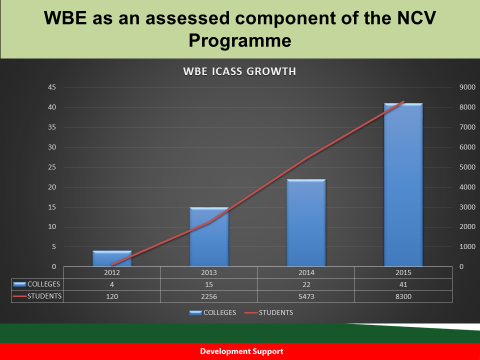Improving Quality through Work Experience: The Workplace Based Experience (WBE) Model for TVET colleges


Institution: Swiss-South African Cooperation Initiative (SSACI)
The Technical and Vocational Education Training (TVET) college system in South Africa introduced the National Certificate Vocational (NCV) programme in 2009. However, the qualification did not include a work integrated learning component. Thus industry was uncertain about the quality of the graduates.
The Swiss-South African Cooperation Initiative (SSACI) is a non-profit organisation working in partnership with government (national and provincial), business sectors and TVET colleges to support and improve the national skills development system in South Africa, and to develop college capacity
SSACI developed the Workplace Based Experience (WBE) model within the NCV context.
The WBE initiative began in 2009 by getting colleges to place students into industry for short periods of exposure during their studies. The five to ten-day placements initially targeted engineering students, and later included other business and hospitality programmes.
A feature of this initiative has been its phased evolution over time; lessons learned in each stage have been incorporated into a succeeding phase to grow the model, illustrated below. SSACI’s approach has been to take incremental steps towards developing a model that can be made to scale and integrated into the TVET college system and the national skills development system.

Examples of good practice features include the following.
-
The work experience is structured to guide both the employer and the student. The task books provide a framework for WBE activities, as well as enabling students to link the theory to their practical experience. As the programme evolved, the task books became part of the college assessment system as part of the Integrated Continuous Assessment (ICASS) of vocational subjects.
-
Students brought back questions, insights and new knowledge to the college environment from their workplace exposure-enriching their engagement with lecturers.
-
Lecturers were placed in workplaces to update them on current technology and work processes within the industry for which they are training students. They then bring new practices, work examples and sample materials back into the classroom.
-
Successful colleges became advocates for the programme, thereby drawing in more colleges. After each cycle, they came together to share best practice, broaden the knowledge base, identify obstacles and discuss how these were solved. A supportive college network grew from this type of engagement.
-
The programme created or strengthened partnerships between local industries and nearby colleges. One such example is that of a manufacturing equipment company that sends its artisans to the nearby college to give workshop training and has donated capital equipment to the college.
-
Course-based WBE in the NCV has gone to scale in the college system, implemented in 13 NCV programmes in all 50 public TVET colleges.
-
The assessed component has also grown; in 2015 it was applied in at least one of the 13 NCV programmes in 41 of the 50 public TVET colleges, as shown below:
-
WBE information is required in the reporting systems for colleges, although WBE is not yet compulsory in all programmes.
-
Over 400 lecturers at 28 public TVET colleges are currently participating in the Work-integrated Learning for Lecturers project.
-
Many of the lessons learned, resources and practices have been incorporated into national policy documents, informing the government’s approach to monitoring and evaluation systems for colleges.

-
It is easier to get employer buy-in for students still studying to come to a workplace for short periods, rather than trying to negotiate long internships.
-
At the beginning of such a process, it was vital to start with colleges in which there were enthusiasm and commitment from people on the ground.
-
Active management and advocacy within the college are crucial, to enable the institutionalisation of the WBE component into college operational plans, finances and schedules.
-
Time frames are an ongoing challenge. Time must be allocated to the WBE component itself, preparatory sessions with students and employers so that expectations, roles, and responsibilities are clear and debriefing sessions.
-
Planning for the WBE needs to take into account practical factors that include challenges around transport, timekeeping by students, issues relating to shift work and stipends can cause problems.
-
There are variations in how WBE has been implemented by different colleges and employers, as this process was scaled up. Time allocations for WBE in specific industry sectors may differ, and the level of support given to students in finding placements may also vary.
MOVING FORWARD ….
-
For the WBE model to become an integral part of the NCV curriculum, DHET needs to get a WIL policy in place, which will ensure colleges dedicate resources towards its implementation.
-
Learnings about WBE from this initiative and features of the model are being taken into current approaches building on the dual-system for artisan apprenticeships.
-
The workplace integration component for college lecturers has also grown into partnerships with other interested agencies. Alignment with national system initiatives such as those relating to the development of TVET lecturer professional qualifications will enable sustainability
RESOURCES
http://www.ssaci.org.za/for-employers/employer-guides
http://www.ssaci.org.za/college-resources/tvet-college-lecturer-development/resources
